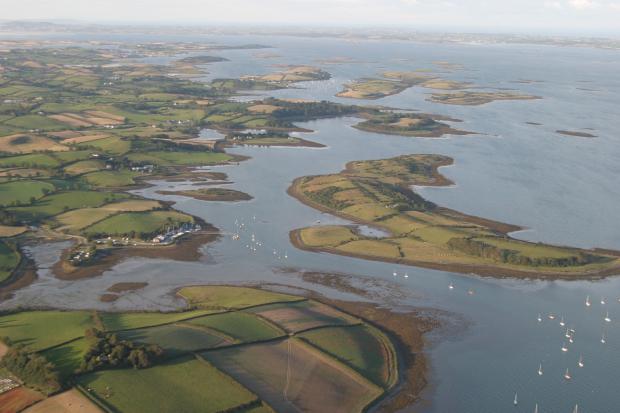
Strangford Lough is one of the largest sea Loughs in Northern Ireland. The sea inlet is made up of a drowned drumlin field, with raised beach terraces shaped by Quaternary glaciation. The drumlins display stages of wave erosion, with a number reduced to rocky islands or 'pladdies'. The Lough is a Earth Science Conservation Review Site (ESCR) because of its coastal processes (contemporary processes at Bar Hall Bay, Gransha Point, Youran, Narrows, Dorn and Northern Mudflats).
There are 120 islands within the Lough and 150 miles of coastline. Intertidal deposits cover some 50km2 and the diversity of marine habitats is internationally renowned. Ten intertidal habitats have been identified on the basis of substrate and wave exposure, each having a characteristic range of species. No comparable area has so wide a range of species or habitats in Northern Ireland. The site is also the most important Irish breeding location for the common seal.
There are a number of species of interest because they are near the northern or southern extremes of their ranges. The richness of the marine flora and fauna can largely be attributed to physiographical features resulting in the immense tidal flow through The Narrows, the range and timing of the tidal variations in the Lough and the wide variety of substrates which occur. Apart from the intertidal communities the site has adjoining habitats which include transitions from salt to freshwater and habitat mosaics. In addition the shoreline habitat incorporates vast areas of mud flats. Of particular note in the Lough are internationally and nationally important populations of waders and wintering waterfowl.
Although there are within the site variations in scientific interest, the variety of features are so diverse and geographically spread that it is important to consider the Lough as a unique and extremely complex, integrated system.
This upper part of Strangford Lough in ASSI Part 1 includes extensive mudflats and also sandflats, saltmarsh and rocky intertidal habitat. The mudflats support luxuriant beds of Zostera (eelgrass). The intertidal mudflats (particularly the Zostera beds) are of great importance as feeding areas for wintering wildfowl and waders. The sandflats and mudflats are especially productive in terms of invertebrate fauna.
The Lough overall supports internationally important numbers of wintering waterfowl and waders most of which favour the mud flat of the Part 1 area. A very significant proportion of the world population of the light-bellied Brent goose occurs on the Lough in early winter. The numbers of redshank, and knot are also of international importance, and several other species occur in large numbers.
The relatively extensive areas of estuarine saltmarsh with its typical assemblage of saltmarsh plants and communities at and around the mouth of the Comber River is a rare habitat in Northern Ireland.
Within Strangford Lough ASSI Part 1 only, small areas of rocky intertidal habitat occur. However, off South Island, at or around the extreme limit of low water spring tides, is a habitat which is unique within Northern Ireland. This is an unusually stable intertidal habitat consisting of cobbles interspersed with occasional larger boulders lightly but firmly embedded in coarse sand and gravel. [picture of common seals] In this habitat there are exceptional growths of many sponge (Porifera) and sea-squirt (Tunicata) species, interspersed with various tube-dwelling worms (Annelida). The diversity of the associated herbivores and detritivores is considerable.
In summer, the islands and surrounding lands provide valuable nesting grounds for a variety of birds. Four species of tern occur in important concentrations, most notably common tern and sandwich tern.
Strangford Lough is the most important breeding site in Ireland for the common seal; North Boretree Rock supports one of the largest colonies. Small numbers of grey seal and otter also occur.
Related articles
- Appointment of Deputy Chair and up to 16 Board Members to the Council for Nature Conservation and the Countryside (CNCC)
- ASSI Guidance for Public Bodies/Competent Authorities
- Coastal Areas of Special Scientific Interest
- Conservation and protection enforcement programme
- Conservation Management Plans (CMPs)
- Ecological Surveys
- European Marine Sites - Marine Special Areas of Conservation and Special Protection Areas
- Financial administrative penalties
- Fishing licence points system for serious infringements of the enforcement programme
- Introduction to Conservation Management Plans (CMPs) for Northern Ireland’s Special Areas of Conservation
- Mandatory recording of marine mammal bycatch
- Marine Conservation Zones
- Marine historic environment
- Marine Protected Areas
- Marine Ramsar sites
- Monitoring marine habitats and species
- NI CHART Bluefin Tuna
- Outline Construction Environmental Management Plan (CEMP)
- Portrush Coastal Zone
- Shipwrecks
- Special Areas of Conservation
- Special Areas of Conservation for Harbour porpoise
- Special Protection Areas
